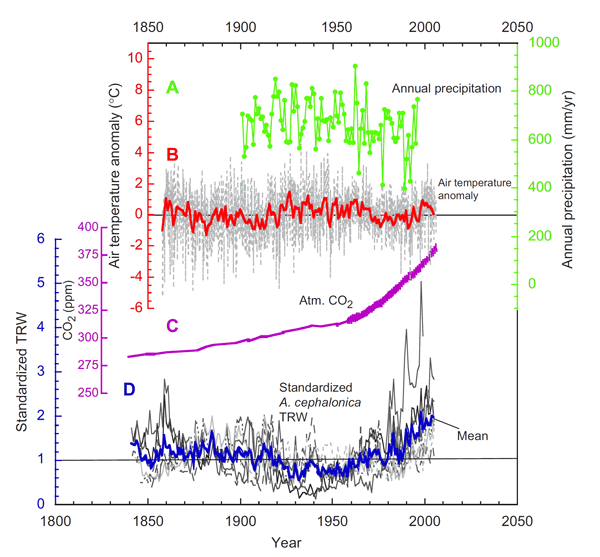Volume 11, Number 49: 3 December 2008
In a study recently published in Dendrochronologia, Koutavas (2008) writes that "tree rings are the primary archive used in annually resolved climate reconstructions spanning recent centuries to millennia, and as such their response to non-climatic factors requires careful evaluation." Stating that an important consideration in this regard "is whether radial growth in trees over the 20th century has been influenced by anthropogenic effects, particularly the rising concentration of CO2 in the global atmosphere," he notes that "LaMarche et al. (1984) were the first to attribute late 20th century growth enhancement in high-elevation bristlecone and limber pines from the western US to CO2 fertilization," adding that "Graybill and Idso (1993) further argued that a CO2 growth effect can be detected in tree-ring chronologies from the southwest US in species exhibiting a strip-bark morphology."
In further exploring this subject, Koutavas analyzed ring-width variations obtained from cores of eight Greek fir (Abies cephalonica) trees growing at elevations between 1300 and 1600 meters on the southern slopes of Mt. Ainos on the island of Cephalonia in the Ionian Sea west of mainland Greece, while he employed climate data from the University of East Anglia to determine whether any growth changes noted over the period of the ring-width record (AD 1840-2005) could be ascribed to any regional climate changes to which the trees might have been exposed.
The results of these operations are depicted in the figure below.

Figure 1. Annual precipitation totals, annual air temperature anomalies, atmospheric CO2 concentrations (from Mauna Loa and Antarctica's Law Dome ice core), and the mean standardized tree-ring series of the Greek fir trees. Adapted from Koutavas (2008).
As can readily be seen from these data, and as stated by Koutavas himself, there was a "strong acceleration of growth over the second half of the 20th century," and he notes that "the sustained increase in growth since 1990 in particular is unprecedented over the full length of the data set." He also correctly notes that these positive growth trends "bear no relationship to regional temperature or precipitation variations and therefore are unlikely to be climatically induced." Last of all, he reports that "disturbance effects from human activities are also unlikely, as the study site lies in a remote forest area with difficult access."
About the only rational explanation for the late 20th-century growth acceleration seen in the ring-width data, therefore, is Koutavas' suggestion that "the enhanced growth reflects a fertilization effect due to rising CO2 in the global atmosphere." We agree. Although the correlation between the increasing trends of both atmospheric CO2 content and ring-width growth over this period does not prove causation, such is certainly a logical conclusion when (1) no other environmental parameter can explain the growth enhancement and (2) the results of hundreds of experiments have shown that tree growth is indeed enhanced in CO2-enriched air (see Trees in our Subject Index).
In light of these observations, we also conclude that tree-ring studies that depict unusual or unprecedented growth accelerations over the latter half of the 20th century - which are correlated with regional temperature data where it has warmed concurrently - may well be yielding a reconstructed warming that is too large for this period, as it likely includes a significant component that is CO2-induced in addition to the component that is temperature-induced, such as, for example, in the recent tree-ring-based temperature reconstruction of Buntgen et al. (2008), which suggests that late 20th-century temperatures were somewhat warmer than medieval temperatures, when such may not really have been the case, as is suggested by much of the data we have compiled (and continue to compile on a weekly basis) in our Medieval Warm Period Project.
Sherwood, Keith and Craig Idso
References
Buntgen, U., Frank, D., Wilson, R., Carrer, M., Urbinati, C. and Esper, J. 2008. Testing for tree-ring divergence in the European Alps. Global Change Biology 14: 2443-2453.
Graybill, D.A. and Idso, S.B. 1993. Detecting the aerial fertilization effect of atmospheric CO2 enrichment in tree-ring chronologies. Global Biogeochemical Cycles 7: 81-95.
Koutavas, A. 2008. Late 20th century growth acceleration in greek firs (Aibes cephalonica) from Cephalonia Island, Greece: A CO2 fertilization effect? Dendrochronologia 26: 13-19.
LaMarche, V.C., Graybill, D.A., Fritts, H.C. and Rose, M.R. 1984. Increasing atmospheric carbon dioxide: tree ring evidence for growth enhancement in natural vegetation. Science 225: 1019-1021.




